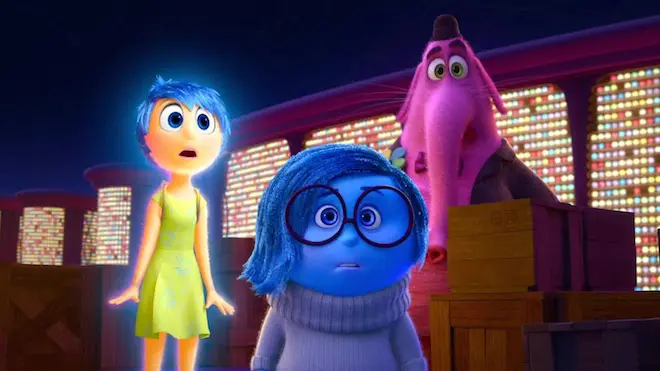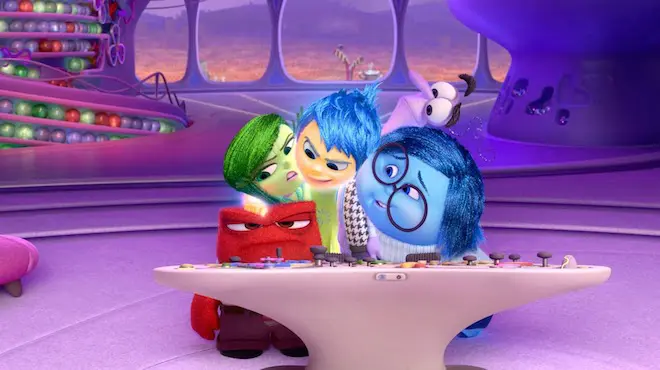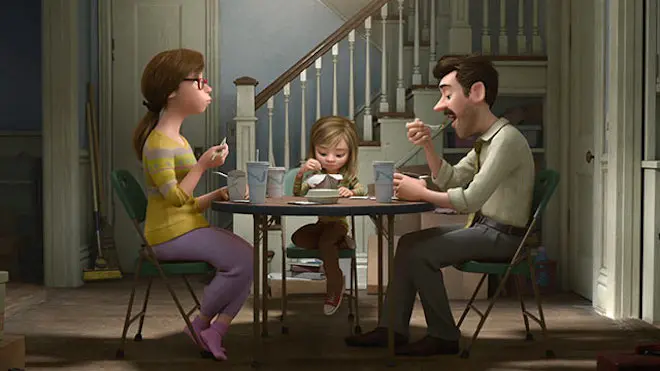Inside Out, the newest Disney Pixar film, delves into the emotional spectrum (both literally and figuratively) to mine gold and to tell the story of a young girl’s life after the emotionally and socially devastating effects of a cross-country move. The premise itself is simple, but the subtext runs deeper — much deeper — to a true emotional level, as the real stars of Inside Out are the emotions that we all feel, brought to life in unique and sometimes hilarious ways.
Riley (voiced by Kaitlyn Dias) and her family, Mom (Diane Lane) and Dad (Kyle MacLachlan) live a quiet, happy life in Minnesota. A life of good friends and of hockey and the bond that only a family shares. But on the inside, Riley is controlled by her five emotions, Joy (Amy Poehler), Sadness (Phyllis Smith), Anger (Lewis Black), Fear (Bill Hader), and Disgust (Mindy Kaling), each adding to her emotional state and the creation of her memories and ultimately her personality.
Pete Docter and Ronaldo Del Carmen, who co-direct and wrote the script with a team, create a unique sub-world within all of our consciences, one that explains much about who we are and why we do the things we do. When you’re angry, it’s because the Anger emotion has the controls inside your brain. When you are depressed, Sadness runs the show. But even deeper than that, there are storehouses for memories, good or bad, and these memories have a shelf life. Once used up or worthless, the memories are then discarded into a chasm in all of us where there is no coming back from. In addition to these rules and characters that Docter and team have created, there are islands that are created by special memories and that serve as the foundations of our personalities. I dare say, Inside Out goes even further in world building here, but the rest I’ll leave for you to discover on your own.
As mentioned, Riley and her family move to San Francisco and her emotions all take a beating, bad things happen, and Pixar makes magic out of tragedy and we all feel something inside. Most of the emotions felt by the audience come from the connection to Riley’s discarded made-up friend, Bing Bong (Richard Kind), who lives deep in her subconscious and still believes that one day, he and Riley will fly away on a rocket ship made up of random childhood items. Bing Bong resonates deeply, with his long, pink trunk and body made up of cotton candy. He is early-childhood personified, and, sadly, he just can’t come to grips with the fact that he’s not a part of Riley’s life any longer. As the things he holds dear are tossed in the chasm, Bing Bong realizes his place in the world, and his actions bring tears to the faces of many in the audience.

Joy, Sadness, and Bing Bong work together to get the two emotions back to the control room of Riley’s mind.
In addition to the heart-tugging emotions that Inside Out brings with it, it’s also a very funny movie. Most of the humor comes from seeing other characters’ emotions at work, including that of a cat’s during the closing credits. Also, pay close attention to the headlines of the newspaper that Riley’s Anger is reading in every scene he’s in. These contextual jokes were some of the best in the film.
Inside Out hits on many adult themes, all the while still entertaining children with its colorful characters and silly situations. While this type of story-telling has been a Disney Pixar trademark since Toy Story hit theaters in 1995, it’s safe to say that here, Pixar and Pete Docter and Ronaldo Del Carmen, and all involved have created one of the best animated films ever. You will laugh, you will cry, and you may actually learn something about yourself and about life, which says a lot when talking about a fictional cartoon.
Inside Out is rated PG and is in theaters now.





